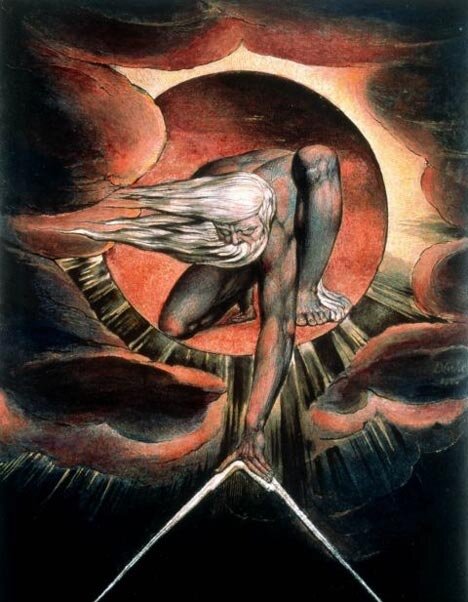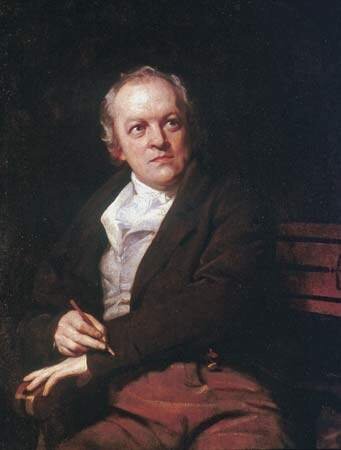William Blake: "Art is the tree of life"

Engravings and watercolors by William Blake (1757 – 1827) were on exhibit at the Petit Palais in Paris in the spring of 2009. As a chance to get to know better this extraordinary, visionary poet, it was an awesome show in the traditional sense of the word.
The following was printed in English on one of the walls of the exhibit when I walked in:
To see a World in a Grain of Sand
And a Heaven in a Wild Flower,
Hold Infinity in the Palm of your Hand
And Eternity in an Hour.
From Auguries of Innocence (Songs of Innocence)
This is what they mean by “visionary” -- to see a world in a grain of sand. He renders into a few words simple, beautiful imagery— the otherwise inexpressible, mystical, we-are-all-one, everything-is-connected, time-is-illusory, universe of the mystic.
Blake concerned himself with BIG questions: Eternity, God, the Word of God, Creation, Heaven, Hell, and Morality (although he apparently had some unconventional, free-love ideas about what was moral and what wasn’t). He was a Philosopher, but an Artist first. Blake was deeply intuitive, seeing everything in abstract, interconnected ways. He took on Newton and the scientists of the age, those linear-thinking, left-brained folks obsessed with reason at the expense of all else, proclaiming, “Art is the tree of life, science is the tree of death.” Goodness. You have to remember it was the Age of Enlightenment—people were turning to the scientific method and reason to explain much of what had been mysterious before —in physics, astronomy, biology, medicine, etc. Blake was decrying those who decided to value science above all else. He knew full well that the physical world was only a small part of our existence, and that to ignore the arts, the humanities, the imagination, and the spirit, at the expense of reason, was foolish and shortsighted. Strangely, this may be an even more important idea today than it was over two hundred years ago.
[From that same poem comes the sensible observation:
“A truth that’s told with bad intent, Beats all the lies you can invent.”]
Most of us have heard, “Tyger, tyger, burning bright/in the forests of the night/what immortal hand or eye/could frame thy fearful symmetry.” [From Songs of Experience] I read it in 9th grade English. While there was something about it that made my pulse beat faster, I didn’t really get it.
I wasn't the only one. In late 18th-century/early 19th century England of his time, Blake was misunderstood at best, mostly considered mad as a hatter and ignored. I’m not sure we’ve caught up with his ideas even yet. Only a few recognized his poetry at the end of his life. As an engraver he enjoyed some admiration; it was said during his time that he “might do tolerably well if he were not mad.” Everyone thought he was bonkers. He was simply brilliant.
Another one of his most famous quotes: “If the doors of perception were cleansed, everything would appear to man as it is, infinite.” From The Marriage of Heaven and Hell
This is allegedly from whence Jim Morrison took the name of his band, The Doors. Jim cottoned to Blake’s line, “The road of excess leads to the palace of wisdom.” As we all know, Morrison died in Paris of an overdose of excess.
One of the first engravings Blake did with his painstaking, carved copper, backward relief-etching is:
“All Religions Are One.”
This was also printed on one of the exhibit walls. Blake had issues with organized religion, although he was a deeply spiritual man. This was very radical thinking at the time. I suppose it is still.
Blake finally put on an exhibit of his artwork above his brother’s hosiery shop, in the early 1820s, accompanied by a 66-page catalog that laid out his unconventional philosophy. Only six people showed up for the opening, including one critic whose review ridiculed Blake as “an unfortunate lunatic.” Tragically, he never tried to exhibit again and secluded himself, embittered.
As if that weren’t bad enough, he had visions throughout his life, some beautiful, many strange and terrible. He tried to reproduce a few of them, including the Ghost of a Flea, definitely something out of a bad dream. Another of these in the exhibit was the portrait of the man who gives him his poems in his dreams. Fortunately, he had a devoted wife Catherine (whom he taught to read and write) who believed in his genius and worked with him throughout his life. And a few benefactors along the way who kept him employed.
One last favorite quote from the long and otherwise (to me) almost incomprehensible Jerusalem:
“Imagination is the real and eternal world of which this vegetable universe is but a faint shadow.”

For all that he suffered of ridicule, neglect, poverty, and torment, in the end, Blake believed that man’s imagination was his connection with the divine. I believe this, too. As we create, we connect with that which created us. Whether we realize it or not. And this can sustain us through pretty much anything.
Keep writing, painting, designing, creating— keep reaching for your dream. Art is the Tree of Life.
For more insight into Blake, check out this review of John Higgs’ William Blake Vs. The World at The Marginalian.
COMING SPRING OF 2023-My latest YA novel: THE COLDEST WINTER I EVER SPENT. 18-year-old suicide prevention worker Delilah’s terminally ill aunt challenges Del’s ideas about life and death



